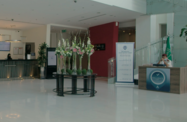Saudi Arabia’s heritage tourism credentials were given a boost in late June, following UNESCO’s decision to add Al Ahsa Oasis to its list of World Heritage sites.

At 160 sq km, Al Ahsa is the largest oasis in the world, located some 60 km from the Gulf coast in the country’s east, and has both environmental and cultural heritage value, according to UNESCO.
In addition to historical sites such as Al Hazm Palace and the Jawatha Mosque, which dates to the 9th century, the area also has a number of archaeological sites containing evidence of human settlements from as far back as the Neolithic period – considered to be between 9000 and 11,000 years ago. It also features some 2.5m date palms, along with a series of gardens, canals, springs, wells and a drainage lake.
Speaking after the UNESCO decision was announced, Prince Sultan bin Salman bin Abdulaziz Al Saud, chairman of the Saudi Commission for Tourism and National Heritage (SCTH), said the recognition could provide an opportunity for the Kingdom to expand its heritage tourism segment.
It has also given impetus to further investment in Al Ahsa’s tourism offering. In early July the SCTH launched a number of projects in the area, including the restoration and rehabilitation of nearby heritage sites and buildings, and the construction of a regional museum.
Al Ahsa joins four other Saudi sites previously granted World Heritage status by the UN organisation – namely, the pre-Islamic archaeological site Al Hijr, often known as Mada’in Saleh; the At Turaif District in ad Dir’iyah, the House of Saud’s first capital; Historic Jeddah; and the ancient rock art of the Ha’il Region.
Cultural tourism key to broader diversification plans
The Kingdom’s growing list of internationally recognised historical attractions is expected to further government plans to expand heritage, culture and entertainment tourism, and boost annual visitor numbers from 18m to 30m by 2030.
In addition to Al Ahsa, a key project in the heritage segment is the development of the Al Ula Region – home to Al Hijr – into a cultural tourism hub, under a 10-year partnership with the government of France.
According to an agreement signed last year, France will create a strategy for new museums and archaeological digs in the region, and issue contracts for infrastructure projects, including transport and hotels. While the size of the investment has yet to be determined, it is estimated to be around $20bn.
In early July construction got under way on another notable development: the 10m-sq-metre Souq Okaz City, developed to support Taif city’s annual cultural and art festival, Souq Okaz.
The project will include interactive learning museums, art spaces, recreational and retail areas, hotels and a convention centre, and will be supported by the development of heritage villages and lodges, ecological camps and medical tourism facilities.
The initial stage has a budget of $217m, though later phases, which feature the construction of an airport and residential community, could take investments to $2bn, according to local press reports.
Both projects are expected to contribute to the achievement of key performance indicators outlined in the Quality of Life Programme 2020, launched in May this year.
In the heritage segment, the programme targets increasing the number of annual heritage events from 23 to 40 by 2020, and expanding related infrastructure, such as museums and facilities to support archaeological digs, from 246 to 450 through a combination of public and private investment.
Hospitality sector to expand in line with tourism offerings
As the portfolio of tourism offerings expands – the SCTH is planning to develop 22 new tourist sites by 2020 across all tourism segments – more investment opportunities are expected to arise in related sectors, such as hospitality and retail.
“Influxes of heritage events, such as the annual Souq Okaz market festival in Taif, are causing domestic tourism to increase, and Saudi Arabia is responding to this transition by further developing its hospitality sector,” Khalid Zahrani, CEO of the Riyadh International Convention & Exhibition Centre, told OBG.
The SCTH forecasts total room numbers will increase from 500,000 as of the end of 2017 to 600,000 by 2020, and is placing a strong focus on private sector involvement in hotel construction.
To encourage a more conducive atmosphere for private investment, the SCTH is working with the Saudi Industrial Development Fund’s Kafalah Programme to provide loans for small and medium-sized enterprises, and the Ministry of Finance has also been brought on-board to provide loans.


